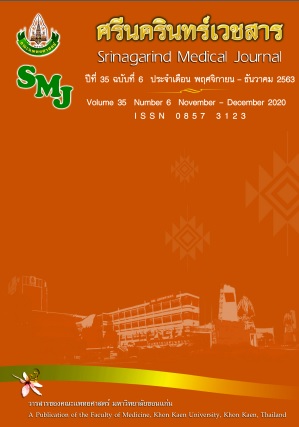Acute Angle Closure Glaucoma
Abstract
ภาวะต้อหินมุมปิดเฉียบพลัน
สุขุมาล ธนไพศาล*, ภาวสุทธิ์ สุภาสัย
หน่วยต้อหิน ภาควิชาจักษุวิทยา คณะแพทยศาสตร์ มหาวิทยาลัยขอนแก่น
ต้อหินมุมปิดเฉียบพลันเป็นภาวะฉุกเฉินทางตาอย่างหนึ่งที่อาจส่งผลให้เกิดภาวะตาบอดถาวรหากไม่ได้รับการรักษาอย่างทันท่วงที สาเหตุหลักเกิดจากม่านตาส่วนขอบติดกับ trabecular meshwork ทำให้มุมตาปิดและไม่สามารถระบายน้ำออกจากตา ส่งผลให้ความดันตาสูงขึ้นทันที ปัจจัยเสี่ยงที่สำคัญคือ อายุมาก เพศหญิง เชื้อชาติเอเชีย และสายตายาว วินิจฉัยได้จากอาการที่เกิดจากความดันลูกตาสูงเฉียบพลัน และการตรวจตาที่แสดงให้เห็นว่ามีมุมตาปิดร่วมกับลักษณะทางกายวิภาคของตาที่เสี่ยงต่อภาวะมุมตาปิด ผู้ป่วยจะมีอาการปวดตามากและตามัวแบบเฉียบพลัน ตาแดง เห็นสีรุ้งรอบดวงไฟ อาจมีคลื่นไส้อาเจียนและปวดศีรษะร่วมด้วย ตรวจตาพบความดันตาสูง ช่องหน้าม่านตาแคบ เลนส์เคลื่อนตัวมาด้านหน้า และมุมตาปิด อาจตรวจพบเส้นประสาทตาบวมร่วมด้วย การรักษาในระยะแรกคือ การลดความดันตาอย่างรวดเร็ว ควบคุมการอักเสบของลูกตา และเปิดมุมตาที่ปิดด้วยการยิงเลเซอร์หรือการผ่าตัดเลนส์ตาร่วมกับสลายพังผืดที่มุมตา ในระยะยาวควรทำการประเมินมุมตาเป็นระยะ ส่วนการผ่าตัดทำทางระบายน้ำในลูกตานั้นจะทำในกรณีที่มุมตาเปิดแล้วแต่ยังไม่สามารถควบคุมความดันตาได้
คำสำคัญ: ต้อหินมุมปิด; ต้อหินมุมปิดเฉียบพลัน; ภาวะฉุกเฉินทางตา
Acute angle-closure glaucoma is an ocular emergency that potentially leads to irreversible blindness if the treatment is delayed. The main etiology is the iridotrabecular contact, resulting in anterior chamber angle closure and inadequate drainage of aqueous humor hence the intraocular pressure (IOP) suddenly increases. Risk of angle closure is high among the elderly, women, Asian population and those with hyperopia. Diagnosis relies on history of symptoms resulting from the acute IOP rising and ocular examination demonstrating angle closure with anatomical risk factors. Patients usually present with acute severe painful blurred vision, ciliary injection, seeing rainbow halo around lights, nausea, vomiting and headache. Ocular examination showed high IOP, shallow anterior chamber, anterior lens position, closed anterior chamber angle, and occasionally, optic disc edema. Treatment consists of immediate IOP reduction, control of inflammation and reopen the angle by laser or lens extraction with goniosynechialysis. Serial gonioscopy is considered for the long-term angle monitoring. Trabeculectomy is performed in cases of uncontrolled IOP after reopening of the angle.
Keyword: angle-closure glaucoma; acute angleclosure glaucoma; ocular emergency


